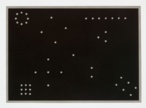
Conceptual Art emerged as an art movement in the 1960s. The expression "concept art" was used in 1961 by Henry Flynt in a Fluxus publication, but it was to take on a different meaning when it was used by Joseph Kosuth (American, 1945-) and the Art & Language group (Terry Atkinson, David Bainbridge, Michael Baldwin, Harold Hurrell, Ian Burn, Mel Ramsden, Philip Pilkington, and David Rushton) in England. For the Art & Language group, concept art resulted in an art object being replaced by an analysis of it. Exponents of Conceptual Art said that artistic production should serve artistic knowledge and that the art object is not an end in itself. The first exhibition specifically devoted to Conceptual Art took place in 1970 at the New York Cultural Center under the title "Conceptual Art and Conceptual Aspects."
Because Conceptual Art is so dependent upon the text (or discourse) surrounding it, it is strongly related to numerous other movements of the last century.
Examples of Conceptual Art:
Marcel Broodthaers (Belgian, 1924-1976), Museum-Museum, 1972, diptych screenprint, composition: 33 x 46 1/2 inches (83.9 x 118.2 cm); sheet (each): 33 x 23 1/4 inches (83 x 59.1 cm); publisher: Edition Staeck, Heidelberg, Germany; printer: Gerhard Steidl, Göttingen, Germany; edition: 100; Museum of Modern Art, NY.
Sol LeWitt (American, 1928-2007), Wall Drawing #263 (A wall divided into sixteen equal parts with all one - two, three and four part combinations of lines in four directions.), 1975, black graphite on wall, dimensions variable, Whitney Museum of American Art, NY. LeWitt's work amounts to a plan or directions to the draftsperson who executes the work, much as an architect presenting plans to a builder. These directions call for dividing a wall into sixteen equal parts with all one, two, three and four part combinations of lines in four directions. The first row of this sixteen-square grid contains lines in the four basic directions-vertical, horizontal, and two diagonals- that establish a system upon which the rest of the drawing is based. Because LeWitt does not use an intermediary support, such as canvas or paper, in the final work, he de-emphasizes the materiality of the aesthetic object, giving priority to the idea behind the art work. See quotes of Lewitt below.
Mel Bochner (American, 1940-), To Count: Intransitive, 1972, soap on glass, dimensions variable, Sonnabend Gallery, NY. Having rubbed a window with a soap film, Bochner drew numbers onto the glass, transforming the window from a material through which to look into one at which to look. The piece cannot be moved, and so cannot be sold as an object. The work must instead be considered the manifestation of an idea, which could be again created elsewhere, any future incarnation necessarily made inexpensively and temporarily.

Mel Bochner, Rules of Inference, 1974, aquatint on paper, plate: 22 1/4 x 31 1/16 inches (56.5 x 78.9 cm), sheet: 29 7/8 x 39 3/16 inches (75.9 x 99.5 cm); printer: Crown Point Press, Oakland; publisher: Parasol Press, NY; edition: 35, Museum of Modern Art, NY.
Hanne Darboven (German, 1941-), Harburg Sand, 1988, screenprint and collotype; composition: 22 3/8 x 23 5/16 inches (56.8 x 59.2 cm); sheet: 38 1/16 x 31 5/16 inches (96 x 79.6 cm); publisher: Edition Schellmann, Munich and New York; printer: Domberger KG, Bonlanden, Germany; edition: 75; Museum of Modern Art, NY.
Lawrence Weiner (American, 1942-), Statement of Intent, 1969 and 1999, enamel on wall, dimensions variable, collection of the artist.
Lawrence Weiner, Rocks Upon the Beach Sand Upon the Rocks, 1988, paint on wall, dimensions variable, Museum of Modern Art, NY.

Joseph Kosuth (American, 1945-), Clock (One and Five), English/Latin version,
1965, clock, photograph
and printed texts on paper,
unique, 61.0 x 290.2 cm,
Tate Gallery, London. See horology
and time.
Joseph Kosuth, One and Three Chairs, 1965, a folding chair, a photograph of a chair, and a photographic enlargement of a dictionary definition of a chair, Chair 32 3/8 x 14 7/8 x 20 7/8 inches (82 x 37.8 x 53 cm), photographic panel 36 x 24 1/8 inches (91.5 x 61.1 cm), text panel 24 x 24 1/8 inches (61 x 61.3 cm), Museum of Modern Art, NY . One and Three Chairs is presented as having no function other as a clear definition of itself. Kosuth wrote the important article "Art after Philosophy," Studio International., 1969. See furniture.
The Russian emigrant conceptual artist team Vitaly Komar and Alex Melamid are responsible for the projects they titled "The Most Wanted paintings" and "The Least Wanted paintings", reflect the artists' interpretation of a professional market research survey about aesthetic preferences and taste in painting. Intending to discover what a true "people's art" would look like, the artists, with the support of the Nation Institute, hired Marttila & Kiley, Inc. to conduct the first poll. In 1994, they began the process which resulted in America's Most Wanted and America's Least Wanted paintings, which were first exhibited under the title "People's Choice." See aesthetics and taste.
![]()
Jenny Holzer (American, 1950-), Truisms, 1983, computerized electronic
sign, 6 5/16 x 60 1/2
x 4 1/4 inches (16 x 153.7 x 10.8 cm), Museum of Contemporary
Art, Chicago, IL.
Also see avant-garde, conceptual, earth art, environment art, Fluxus, Happening, interdisciplinary, Minimalism, and postmodernism.
https://inform.quest/_art
Copyright © 1996-![]()